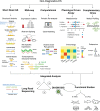A guide for the diagnosis of rare and undiagnosed disease: beyond the exome
- PMID: 35220969
- PMCID: PMC8883622
- DOI: 10.1186/s13073-022-01026-w
A guide for the diagnosis of rare and undiagnosed disease: beyond the exome
Abstract
Rare diseases affect 30 million people in the USA and more than 300-400 million worldwide, often causing chronic illness, disability, and premature death. Traditional diagnostic techniques rely heavily on heuristic approaches, coupling clinical experience from prior rare disease presentations with the medical literature. A large number of rare disease patients remain undiagnosed for years and many even die without an accurate diagnosis. In recent years, gene panels, microarrays, and exome sequencing have helped to identify the molecular cause of such rare and undiagnosed diseases. These technologies have allowed diagnoses for a sizable proportion (25-35%) of undiagnosed patients, often with actionable findings. However, a large proportion of these patients remain undiagnosed. In this review, we focus on technologies that can be adopted if exome sequencing is unrevealing. We discuss the benefits of sequencing the whole genome and the additional benefit that may be offered by long-read technology, pan-genome reference, transcriptomics, metabolomics, proteomics, and methyl profiling. We highlight computational methods to help identify regionally distant patients with similar phenotypes or similar genetic mutations. Finally, we describe approaches to automate and accelerate genomic analysis. The strategies discussed here are intended to serve as a guide for clinicians and researchers in the next steps when encountering patients with non-diagnostic exomes.
Keywords: Diagnosis; Exome-negative; Long read; Omics; Rare.
© 2022. The Author(s).
Conflict of interest statement
EAA is co-founder to Personalis, DeepCell, Svexa; non-executive director to AstraZeneca and advisor to Genome Medical, Sequence Bio, Apple, Foresite Capital. The remaining authors declare that they have no competing interests.
Figures


References
-
- National Diabetes Statistics Report, 2020 [Internet]. 2020 [cited 2021 May 18]. Available from: https://www.cdc.gov/diabetes/data/statistics-report/index.html
-
- RARE disease facts [Internet]. Global Genes. 2018 [cited 2021 Dec 20]. Available from: https://globalgenes.org/rare-disease-facts/
-
- Global Commission on Rare Disease [Internet]. [cited 2021 Dec 6]. Available from: https://www.globalrarediseasecommission.com/Report
Publication types
MeSH terms
Grants and funding
LinkOut - more resources
Full Text Sources

